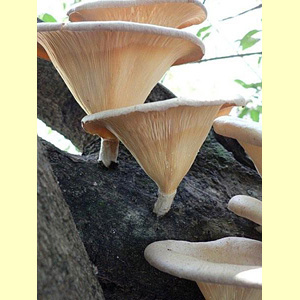
images/Lentinus/Lentinus_sajor_caju_Guard_NSW_NP_113.jpg
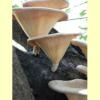
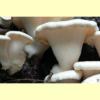
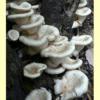
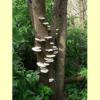
Diagnostic characters
Tough, medium to very large agaric, growing on litter or mulch or wood, rarely on the ground, with a white spore print. Pileus white, pale, yellow, brown or grey, not viscid; surface glabrous to fibrillose or scaly. Lamellae decurrent. Stipe central, excentric or lateral. Partial veil remnants a ring zone, a membranous annulus or absent. Spores cylindrical to bacilliform, hyaline, non-amyloid, smooth; germ pore absent. Cheilocystidia present. Lamellar trama interwoven, descending or radiate. Context dimitic with skeleto-ligative hyphae. Pileipellis a cutis. Clamp connections present.
Similar genera
The tough texture distinguishes Lentinus from other white-spored agarics with an infundibuliform pileus and decurrent lamellae growing on wood, such as Omphalotus and Pleurotus. The genus Panus is similar in texture and habit, but it often has a velvety to hispid pileus surface and never has an annulus. It also differs in the presence of skeletal hyphae (rather than skeleto-ligative hyphae), and several species have thick-walled pleurocystidia. Pleurotus tuber-regium is dimitic but has skeletal rather than skeleto-ligative hyphae, and the fruit-body usually arises from a sclerotium. Austrolentinus has a very dark fruit-body, ellipsoid spores and the pileipellis is a trichoderm of coralloid hyphae. The hyphal pegs on the lamellae of Lentinus are found otherwise in lamellate macrofungi only in Gloeophyllum.
Citation
Lentinus Fr., Syst. Orb. Veg. 77 (1825).
Australian species
Three species: Lentinus concinnus, L. sajor-caju (= Pleurotus) and L. squarrosulus. A number of other species have been recorded but require confirmation.
Australian distribution
W.A., N.T., Qld and N.S.W.
Habitat
In native forests.
Substrate
On sticks and larger wood, especially fallen logs, sometimes on the ground (attached to buried wood).
Trophic status
Saprotrophic.
References
Corner, E.J.H. (1981), The agaric genera Lentinus, Panus and Pleurotus with particular reference to Malaysian species, Beih. Nova Hedwigia 69: 1–169. [Description and Microcharacters of L. concinnus (under the name L. tigrinus, which is misapplied according to Pegler (1983)), L. sajor-caju and L. squarrosulus, and B&W Illustration of L. sajor-caju, along with Key to Malaysian species]
Pegler, D.N. (1983b), The genus Lentinus: a world monograph, Kew Bull., Addit. Ser. 10: 1–281. [Description, B&W Illustration and Microcharacters of Lentinus concinnus, L. sajor-caju and L. squarrosulus, and Key to world species, under Lentinus subgenus Lentinus]
Pegler, D.N. (1986), Agaric flora of Sri Lanka, Kew Bull., Addit. Ser. 12: 1–519. [Description, B&W Illustration and Microcharacters of Description, B&W Illustration and Microcharacters of L. sajor-caju and L. squarrosulus]
